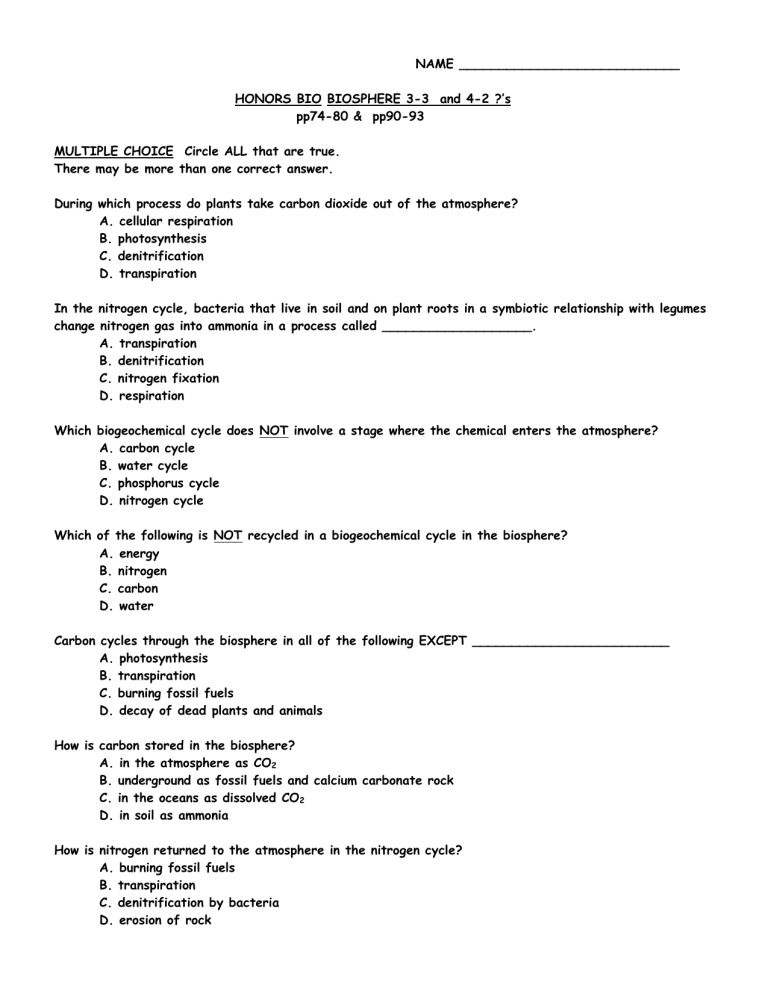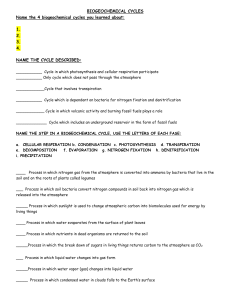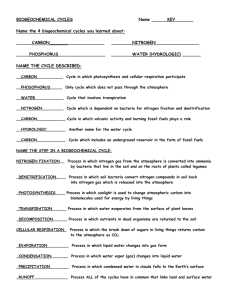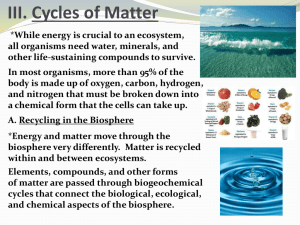NAME HONORS BIO BIOSPHERE 3-3 and 4-2 ?`s pp74

NAME ____________________________
HONORS BIO BIOSPHERE 3-3 and 4-2 ?’s
pp74-80 & pp90-93
MULTIPLE CHOICE Circle ALL that are true.
There may be more than one correct answer.
During which process do plants take carbon dioxide out of the atmosphere?
A. cellular respiration
B. photosynthesis
C. denitrification
D. transpiration
In the nitrogen cycle, bacteria that live in soil and on plant roots in a symbiotic relationship with legumes change nitrogen gas into ammonia in a process called ___________________.
A. transpiration
B. denitrification
C. nitrogen fixation
D. respiration
Which biogeochemical cycle does NOT involve a stage where the chemical enters the atmosphere?
A. carbon cycle
B. water cycle
C. phosphorus cycle
D. nitrogen cycle
Which of the following is NOT recycled in a biogeochemical cycle in the biosphere?
A. energy
B. nitrogen
C. carbon
D. water
Carbon cycles through the biosphere in all of the following EXCEPT _________________________
A. photosynthesis
B. transpiration
C. burning fossil fuels
D. decay of dead plants and animals
How is carbon stored in the biosphere?
A. in the atmosphere as CO
2
B. underground as fossil fuels and calcium carbonate rock
C. in the oceans as dissolved CO
D. in soil as ammonia
2
How is nitrogen returned to the atmosphere in the nitrogen cycle?
A. burning fossil fuels
B. transpiration
C. denitrification by bacteria
D. erosion of rock
How is the movement of matter through the biosphere different from the flow of energy?
A. Matter is recycled within and between ecosystems thorough biogeochemical cycles.
B. Energy is recycled within and between ecosystems thorough biogeochemical cycles.
C. Matter flows one way through an ecosystem and is used up
D. Energy flows one way through an ecosystem and is used up.
Which biomolecules found in living things contain carbon? (Circle ALL that are TRUE)
A. nucleic acids (DNA & RNA)
B. lipids
C. carbohydrates
D. ATP
E. proteins
Which biomolecules found in living things contain phosphorus? (Circle ALL that are TRUE)
A. nucleic acids (DNA & RNA)
B. phospholipids
C. carbohydrates
D. ATP and NADPH
E. proteins
Name the 3 types of SYMBIOSIS
TYPES OF SYMBIOSIS DESCRIPTION
Relationship in which one organism benefits, but the other in neither helped nor harmed
Relationship in which one organism benefits and the other is harmed in some way
Relationship in which both organisms benefit
Use what you learned about limiting nutrients to explain why many lakes in South Dakota turn green in late summer.
_____________________________________________________________________
___________________________________________________________________________
EXPLAIN how predators and prey interact in an ecosystem. (Don’t just tell me one eats and the other is eaten. There is a balance and interaction between the two.) What happens to the predator population when the prey population decreases and vice versa?
____________________________________________________________________________
____________________________________________________________________________
COMPARE AND CONTRAST
WAY THEY ARE
DIFFERENT
WAY THEY ARE ALIKE
RESOURCE
WAY THEY ARE
DIFFERENT
WAY THEY ARE ALIKE
WAY THEY ARE
DIFFERENT
WAY THEY ARE ALIKE
BIOTIC FACTOR
TRANSPIRATION
NUTRIENT
ABIOTIC FACTOR
EVAPORATION











